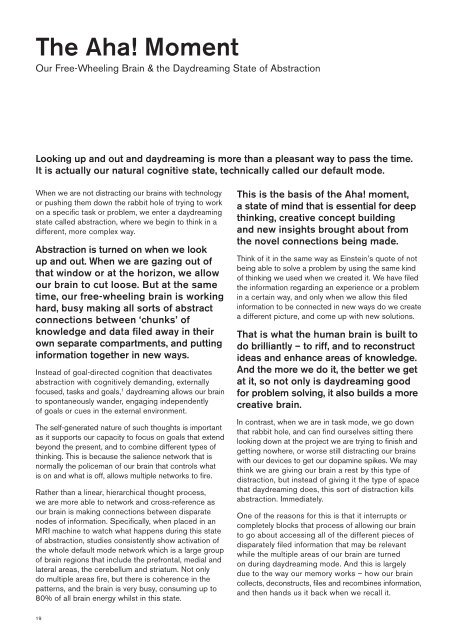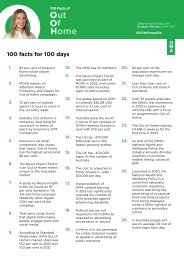THE ART AND SCIENCE OF LOOKING UP REPORT
Create successful ePaper yourself
Turn your PDF publications into a flip-book with our unique Google optimized e-Paper software.
The Aha! Moment<br />
Our Free-Wheeling Brain & the Daydreaming State of Abstraction<br />
Looking up and out and daydreaming is more than a pleasant way to pass the time.<br />
It is actually our natural cognitive state, technically called our default mode.<br />
When we are not distracting our brains with technology<br />
or pushing them down the rabbit hole of trying to work<br />
on a specific task or problem, we enter a daydreaming<br />
state called abstraction, where we begin to think in a<br />
different, more complex way.<br />
Abstraction is turned on when we look<br />
up and out. When we are gazing out of<br />
that window or at the horizon, we allow<br />
our brain to cut loose. But at the same<br />
time, our free-wheeling brain is working<br />
hard, busy making all sorts of abstract<br />
connections between ‘chunks’ of<br />
knowledge and data filed away in their<br />
own separate compartments, and putting<br />
information together in new ways.<br />
Instead of goal-directed cognition that deactivates<br />
abstraction with cognitively demanding, externally<br />
focused, tasks and goals, 1 daydreaming allows our brain<br />
to spontaneously wander, engaging independently<br />
of goals or cues in the external environment.<br />
The self-generated nature of such thoughts is important<br />
as it supports our capacity to focus on goals that extend<br />
beyond the present, and to combine different types of<br />
thinking. This is because the salience network that is<br />
normally the policeman of our brain that controls what<br />
is on and what is off, allows multiple networks to fire.<br />
Rather than a linear, hierarchical thought process,<br />
we are more able to network and cross-reference as<br />
our brain is making connections between disparate<br />
nodes of information. Specifically, when placed in an<br />
MRI machine to watch what happens during this state<br />
of abstraction, studies consistently show activation of<br />
the whole default mode network which is a large group<br />
of brain regions that include the prefrontal, medial and<br />
lateral areas, the cerebellum and striatum. Not only<br />
do multiple areas fire, but there is coherence in the<br />
patterns, and the brain is very busy, consuming up to<br />
80% of all brain energy whilst in this state.<br />
This is the basis of the Aha! moment,<br />
a state of mind that is essential for deep<br />
thinking, creative concept building<br />
and new insights brought about from<br />
the novel connections being made.<br />
Think of it in the same way as Einstein’s quote of not<br />
being able to solve a problem by using the same kind<br />
of thinking we used when we created it. We have filed<br />
the information regarding an experience or a problem<br />
in a certain way, and only when we allow this filed<br />
information to be connected in new ways do we create<br />
a different picture, and come up with new solutions.<br />
That is what the human brain is built to<br />
do brilliantly – to riff, and to reconstruct<br />
ideas and enhance areas of knowledge.<br />
And the more we do it, the better we get<br />
at it, so not only is daydreaming good<br />
for problem solving, it also builds a more<br />
creative brain.<br />
In contrast, when we are in task mode, we go down<br />
that rabbit hole, and can find ourselves sitting there<br />
looking down at the project we are trying to finish and<br />
getting nowhere, or worse still distracting our brains<br />
with our devices to get our dopamine spikes. We may<br />
think we are giving our brain a rest by this type of<br />
distraction, but instead of giving it the type of space<br />
that daydreaming does, this sort of distraction kills<br />
abstraction. Immediately.<br />
One of the reasons for this is that it interrupts or<br />
completely blocks that process of allowing our brain<br />
to go about accessing all of the different pieces of<br />
disparately filed information that may be relevant<br />
while the multiple areas of our brain are turned<br />
on during daydreaming mode. And this is largely<br />
due to the way our memory works – how our brain<br />
collects, deconstructs, files and recombines information,<br />
and then hands us it back when we recall it.<br />
Daydreaming mode is turned on when we<br />
The time we spend in daydreaming state<br />
look up and out.<br />
can be between 30% to 50% of waking life.<br />
This is the state of abstraction, the basis of<br />
the Aha! moment, and essential for deep thinking,<br />
creative concept building and new insights.<br />
19<br />
20















